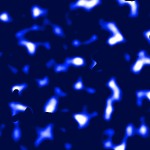Mapping the invisible
Astronomers don’t know what dark matter is, but they have mapped where it’s hiding
Share this:
- Share via email (Opens in new window) Email
- Click to share on Facebook (Opens in new window) Facebook
- Click to share on X (Opens in new window) X
- Click to share on Pinterest (Opens in new window) Pinterest
- Click to share on Reddit (Opens in new window) Reddit
- Share to Google Classroom (Opens in new window) Google Classroom
- Click to print (Opens in new window) Print

Most maps show places you can visit and how to get there. Most maps, however, were not made by astronomers — physicists who study stars and galaxies far, far, far away. At a recent meeting in Texas, three teams of these scientists presented new maps unlike any atlas, globe or street guide. These maps show where dark matter, giant blobs of invisible stuff, lurks.
One of the most mysterious – and common – materials in the cosmos, dark matter forms in giant clusters and long strings. It hides all throughout the universe, although you’ll never see it no matter how hard you look.
Dark matter is literally the darkest stuff imaginable. It neither produces nor reflects light. And that makes it invisible to human eyes and to most scientific instruments. It also makes it a challenge to measure and study. What makes this type of matter more frustrating: Scientific measurements show that the universe holds about five times as much dark matter as ordinary matter. Ordinary matter, which makes up the known (and knowable) part of the universe, includes you, your dog, Earth, the sun, stars and planets.
Scientists find dark matter in the same way they detect other things we can’t see — by observing how the invisible stuff affects things we can see. We can’t see wind, for example, but we can feel a breeze or watch a windmill spinning on a hill. Dark matter doesn’t spin windmills, but it does have gravity. Like ordinary matter, dark matter pulls on everything around it with gravity. Dark matter’s gravity holds galaxies together and bends rays of light as they stream past — in much the same way light bends as it travels through water or glass.
To make the new maps, astronomers trained powerful telescopes on large patches of sky to watch for distorted light arriving from distant galaxies. One group used a telescope perched 14,000 feet above sea level atop a dormant Hawaiian volcano. It recorded light from stars and other celestial bodies. Two other groups used a telescope on top of a mountain in New Mexico, which watched the sky for nine years.
These telescopes recorded light that came from galaxies billions of light-years away. (A light-year is the distance traveled by light in one year. It’s about 25 million times the distance from Earth to the moon.) By studying how the light changed as it traveled through space, the astronomers could estimate the rough location and shape of dark matter clumps.
The scientists’ work is like figuring out how big and thick a pair of eyeglasses is by looking through them and measuring how differently the world appears.
“You can imagine that dark matter is leaving its signature on the images of very distant galaxies,” said Catherine Heymans. She’s an astronomer at the University of Edinburgh in Scotland. She worked on the team that used data from the Hawaiian telescope.
Her team’s map shows that giant blobs of dark matter reside with giant blobs of ordinary matter, such as big galaxies or galactic groups. Even though scientists already suspected that dark matter and ordinary matter show up in much the same places, it was reassuring to see the same connection in the maps.
“We are very happy that this is very similar to what we’ve been expecting,” Ludovic Van Waerbeke told Science News. He works at the University of British Columbia in Vancouver .
One of the new maps shows dark matter in a swath of sky that to the naked eye is more than 600 times as large as a full moon. The other covers an area more than a thousand times as large. But that’s just the beginning: The astronomers want to conduct further studies to better understand those invisible lumps and hope to survey the whole sky within 10 years or so.
POWER WORDS
matter Something that occupies space and has a mass.
mass The amount of matter in an object.
dark matter Physical objects or particles that emit little or no detectable radiation of their own and are believed to exist because of unexplained gravitational forces that they appear to exert on astronomical objects that we can see.
gravity The force that attracts any body with mass toward any other body with mass. The more mass something has, the more gravity there is.






